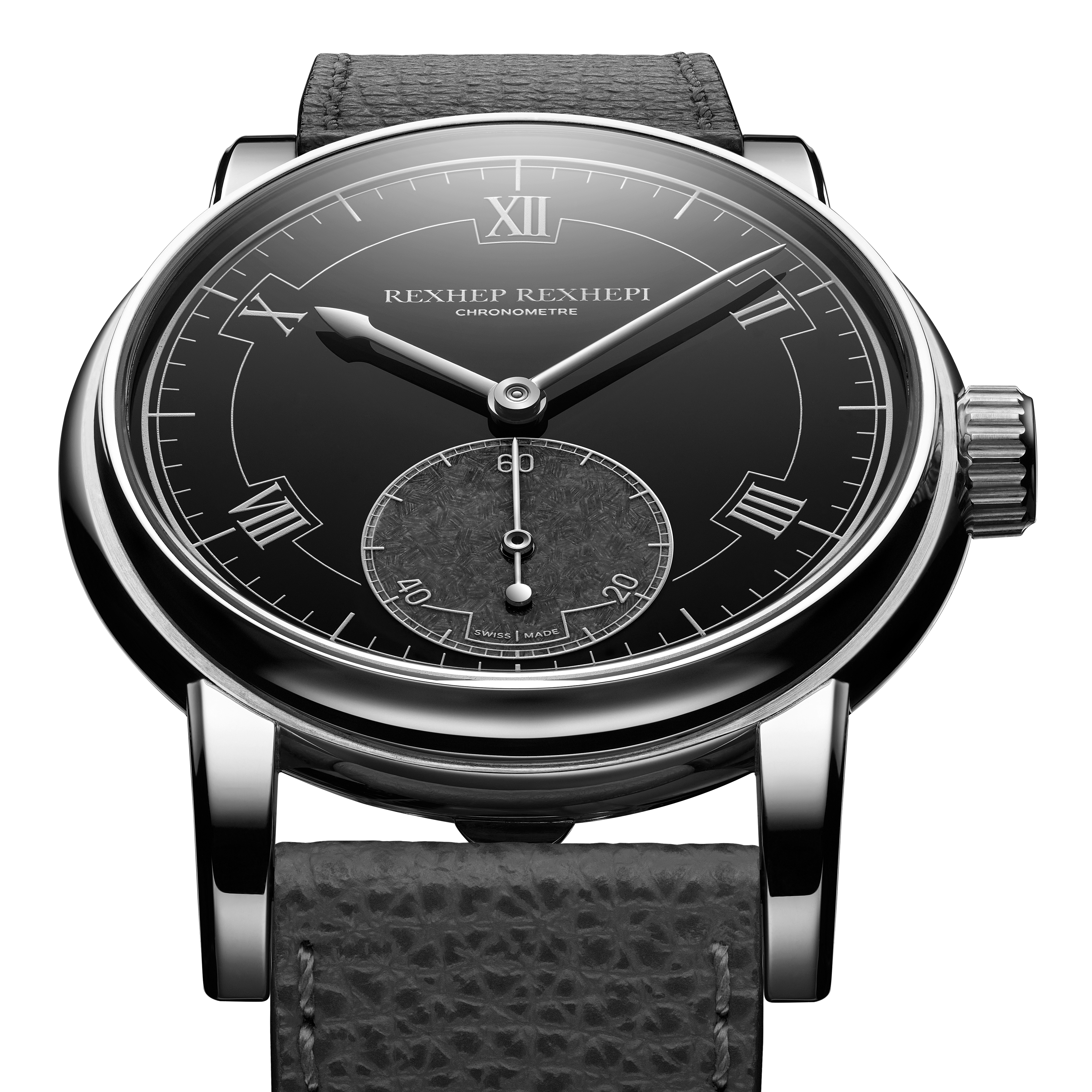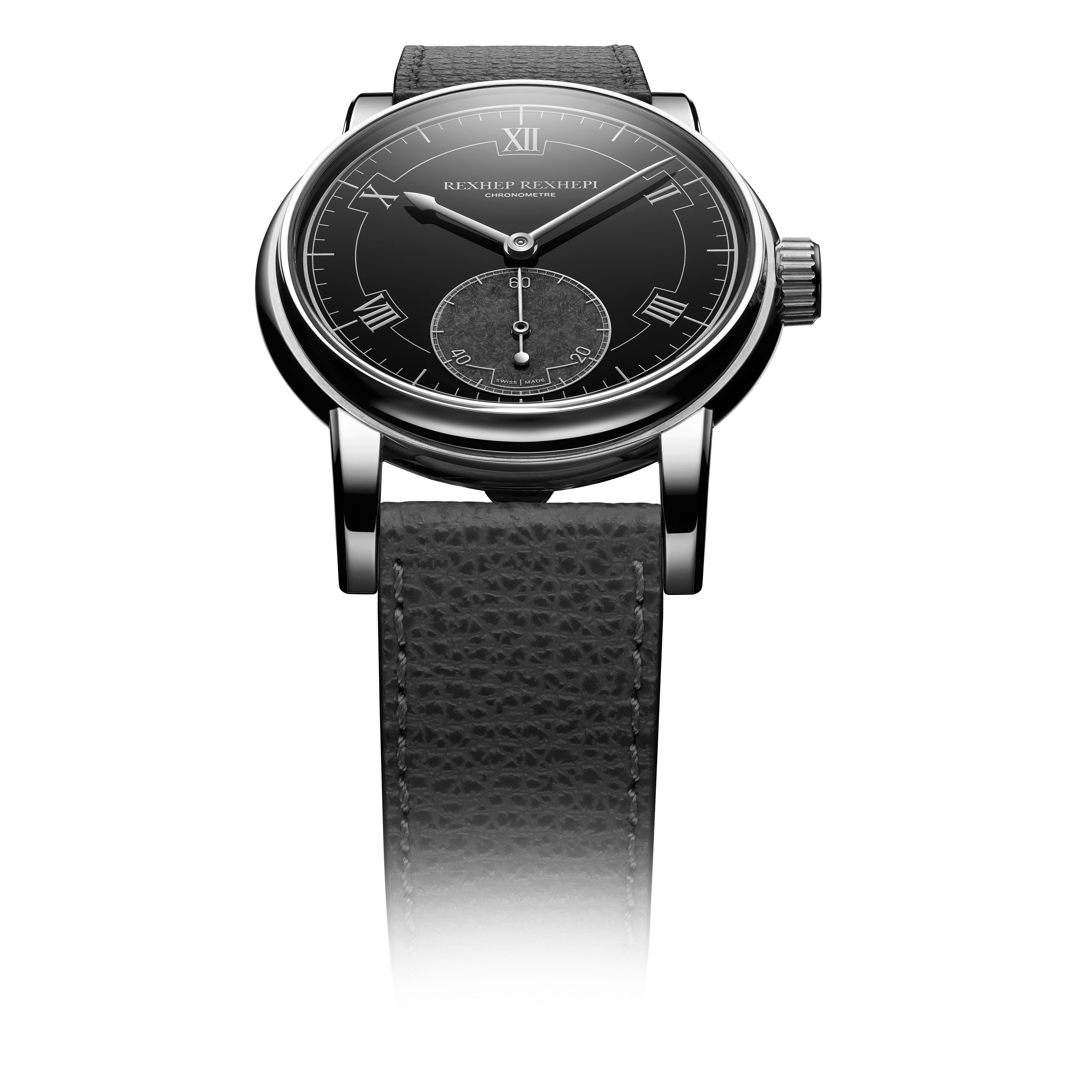
Chronomètre Contemporain II
Power reserve: 82 h, 21600 vph
Dead-beat second
AKRIVIA was established to produce fine watches in the grand tradition of Swiss watchmaking, particularly that of the haute horlogerie brands long based in Geneva – an ambition that took physical form with the first Chronomètre Contemporain (RRCC I), which won the Men’s Watch Prize at the 2018 Grand Prix d’Horlogerie de Genève.
The crystallisation of founder Rexhep Rexhepi’s long-held aspirations, the RRCC I is an artful fusion of the storied past of Swiss watchmaking combined his vision of its future. The RRCC I combined classical design and finishing but was subtly elevated with contemporary flourishes. The dial, for instance, is grand feu enamel, the standard material for dials in high-quality 19th century pocket watches but endowed with a design that’s a modern twist on the traditional “sector” dial of the 1930s and 1940s.
THE RRCC II IS BUILT ON THE SAME PRINCIPLES BUT TAKEN TO THE NEXT LEVEL.
A FAMILIAR FACE
On the front, the RRCC02 preserves the refined guise of the first edition. Once again grand feu enamel, the dial retains the chapter ring characterised by alternating Roman numerals.
The vitreous enamel dial is produced the old-fashioned way – with a skilled hand and a fine paintbrush – and then fired in an oven, a process that has to be repeated several times to achieve the glossy, indelible finish that defines true enamel. Once perfect, the enamel dial is lapped with an abrasive paste to hone the surface until it is almost glassy in its smoothness.
Painstaking as it is, the process has to be repeated because each dial is made of two parts soldered together: the recessed subsidiary seconds and the main dial. Notably, one of the subtle refinements of the dial from the first to second generation literally lies in between the two parts – the dial now does away with the gold retaining ring around the seconds register, allowing the sub-dial to join seamlessly with the main section of the dial.
The markings on the dial are also fired enamel; first printed in liquid enamel and then fired once again to set the markings. Continuing the careful refinements that characterise the RRCC02, the markings have been subtly reworked – the hour markers are rendered in a heavier font, giving them greater presence.
The case is paired with a fired enamel dial in piano black – lustrous, deep black with a glossy finish – with all the markings in ivory enamel. Seemingly stark and monochromatic at a distance, the black dial has a decorative detail apparent only up close: the seconds register is finished with a handengraved gratté pattern that’s then covered with translucent grey enamel.
MECHANICAL MARVEL
Turn the watch over and the RRCC02 movement has an uncanny air, appearing identical to its predecessor at first glance, but revealing itself to be a different reality with a second look, like déjà vu after a lucid dream. A wholly new construction with different mechanics and functions, the new calibre has been carefully conceived to echo the design of the first edition.
THE OUTLINE OF THE RRCC02 IS QUINTESSENTIAL AKRIVIA: A GRACEFULLY SYMMETRICAL BARREL BRIDGE SECURES TWIN MAINSPRINGS, EACH DRIVING A DISCRETE FUNCTION.
One barrel supplies energy to the balance wheel, the beating heart of the watch responsible for keeping the time. And the other drives the jumping seconds, allowing the seconds hand to leap forward crisply in one-second steps without impacting the movement’s precision. This twin-train construction is novel and stands in contrast to the conventional, single-going train setup of the first edition.
JUMP, HACK, RESET
Beneath the seconds lies the hacking and reset function. Pull the crown and the seconds hand will instantaneously return to 12 o’clock and halt, a convenient feature that allows for precise time setting.
The elegant simplicity of the function – the seconds hand resets and halts in the blink of an eye – belies its complexity.
Once the crown is pulled, a mechanical ballet unfolds behind the dial. The process begins with a long arm known as the hacking lever, which touches the rim of the balance wheel, stopping its oscillations and freezing the movement.
The same lever also activates the brake for the seconds wheel, halting its motion in order to safely accomplish the final step – the zero reset of the seconds hand.
Relying on a heart-shaped cam and reset hammer, the reset mechanism is identical to that of a chronograph. The hammer falls, causing the cam to rotate until the hammer lies at the lowest point of the cam’s outline, sending the seconds hand back to 12 o’clock.
ACCOMPLISHED AS THEY ARE, THE COMPLICATIONS OF THE RRCC02 WERE NOT DEVISED MERELY FOR INTELLECTUAL SATISFACTION.
The keyless works under the dial, namely the mechanism that winds and sets the movement, were designed to be both robust and tactile, resulting in a crisp and satisfying action that can be enjoyed through the operation of the crown.
TECHNICAL TWEAKS
Beyond the new complications, the RRCC02 is a tangibly improved timekeeper that lives up to the “chronometer” appellation. For one, the calibre utilises a newly designed balance wheel that relies on regulating screws instead of circular weights. As a result, it boasts 60% more inertia than the balance of the first edition. Combined with a mainspring that delivers 40% more torque, the RRCC02 offers more stable timekeeping over longer periods.
CASE MANUFACTURE
The RRCC02 is contained within a case produced in-house by AKRIVIA at the workshop overseen by famed case maker Jean-Pierre Hagmann. Made up of 15 parts, including lugs individually soldered to the case middle, the case has been refined in ways that are significant but subtle over that of the first edition.
The purpose of the redesign was to perfect its overall proportions, resulting in a more harmonious balance between the various elements. That required tweaking every aspect of the case such that, despite the inherited aesthetics, the case is wholly new – none of the component are interchangeable between the two editions.
Amongst the refinements is a sapphire crystal with a more pronounced dome. Another is the geometry of the lugs, a defining feature of the first edition. The gracefully arched lugs were modelled on mid 20th century gentlemen’s watches, particularly those with cases produced by Emile Vichet, an esteemed casemaker. They have been elongated on the RRCC II, giving them a more graceful sweep downwards.
THE CASE WAS DESIGNED FOR SUPERIOR USABILITY DOWN TO THE SMALLEST DETAIL: THE CROWN HAS A SLIGHTLY LARGER DIAMETER TO ALLOW FOR BETTER GRIP AND EASIER WINDING
CALIBER RRCC II
Movement
CALIBRE RRCC02 with dead-beat seconds featuring hacking and zero-reset functions
Technical features
The RRCC02 is equipped with twin gear trains and barrels arranged symmetrically, a unique construction that ensures consistent, exact motion of the jumping seconds hand. The dead-beat, or jumping, seconds is driven by a star and flirt, and powered by its own gear train. Since the seconds has its own energy source, the construction eliminates any energy drain on the regulating organs of the movement, resulting in superior chronometry.
Positioned adjacent to the twin barrels, the stop-work mechanism for the barrels takes the form of a black-polished, bar-shaped spring with an integral pawl. The construction was designed to prevent the over-tensioning of the main springs and backlash, while also preserving the pronounced symmetry of the movement.
The manufacturing of the components required a substantial degree of handwork due to the use of traditional equipment such as turning lathes and precision milling machines.
Finishing
The main plate and bridges are made of environmentally-friendly, unleaded German silver, also known as maillechort, an alloy that boasts ideal mechanical and physical properties, making it the perfect material for functional stability and decorative treatment.
The movement is decorated with traditional techniques that are all executed by hand to the highest standards of the traditional Genevan watchmaking. The techniques include: Côtes de Genève; perlage; circular graining; anglage with polished inward angles; polished countersinks for jewels and screws; black-polished steel parts including screws and balance bridge.
As an example, the quality of finish is illustrated by the wheels of the going trains, which are finished with hand-polished bevels on their spokes and inner edges, resulting in 140 inward angles across the wheels of both trains.
All markings on the movement bridges are engraved by hand in a serif font.
Dial
Grand feu enamel in black with markings in ivory enamel; seconds register in translucent grey enamel over a hand-engraved gratté pattern.



